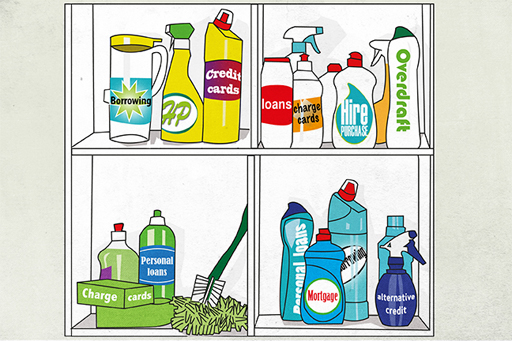9 Debt products
Here’s a run-down of the most common forms of borrowing.
Overdrafts: a flexible means of accessing debt on a bank current account, up to a limit approved by the lender. Banks are no longer allowed to charge daily or monthly fees for overdrafts, but as a result the interest rate charged can now be very high (as much as 40% per annum).
Credit cards (including store cards): their credit limits are set by the lender and normally require a minimum amount to be repaid each month – typically between 2% and 5% of the balance of debt. They might offer a short period of interest-free credit until payment is due. Credit cards vary widely in the interest rate charged on the balance that is not paid off and normally the interest rate charged is high. Store cards are a form of credit card used for buying from specified outlets. They tend to have much higher interest rates than credit cards.
Charge cards: can be used like credit cards to make purchases and obtain approximately two months’ free credit between purchase and paying off the outstanding amount. Charge cards differ from a credit card in that a borrower is required to pay off the entire balance each month. The two-month free credit period arises when the charge card bill is sent out monthly, with a further month in which to settle the bill. A fee might be payable for the card.
Personal loans: loans made to individuals, typically with terms of between 1 and 10 years. They may be either unsecured or secured debt against a property (such as a house) or other assets. Unsecured personal loans are not contractually linked to any assets the borrower buys. These are available from credit unions, banks, building societies, direct lenders and finance companies.
Student loans: loans used to finance further and higher education studies. We looked at these in Session 4.
Hire purchase (HP): a form of secured debt where payments (interest and part repayment of the principal) are made over a period, normally of up to 10 years, to purchase specific goods. The legal ownership of the product only passes to the borrower when the final instalment has been paid.
Mortgages: loans to purchase property or land, which are secured against these assets. Debt terms for mortgages are normally up to 25 or 30 years. There are many types of mortgage. It’s possible, for example, to fund spending through equity withdrawal mortgage products where you borrow money on the basis of the amount of any remaining mortgage.
Alternative credit: these include buying on instalments through mail-order catalogues, doorstep lending and ‘payday lending’, which is described in the next section. These areas are known as ‘sub-prime’ lending, which is lending to people who have poor creditworthiness and who, as a result, have a high risk of being unable to repay money they have borrowed. Commonly, interest rates are very high and there are heavy penalties for late payment.
Peer-to-peer (Peer2Peer) lending: this is an emergent form of lending in the UK and involves savers pooling funds to lend on (on-lending) to individuals and businesses. This form of lending, arranged through intermediaries like Zopa and Financial Circle, circumvents banks and other conventional lenders.
Personal contract purchase (PCP): an increasingly popular form of car finance. These normally involve making a monthly payment for 2 or 3 years at which point the residual sum left to be paid-off on the car purchase is the same as its trade-in value. At this point consumers can either make a one-off payment to complete the purchase or trade the car in for a new one (and a new PCP deal).
Budgeting loans: These are loans that are available to those receiving certain government benefits like Jobseeker’s Allowance. The loans, provided by the government, are for amounts between £100 and £812 (as at 2023).
Activity 5 Put them in order
You’ve looked at the range of debt products. Now put them in order, starting with the cheapest (the lowest interest rate) and ending with the most expensive
- Store card
- Unsecured bank loan
- Overdraft
- Payday loan
- Credit card
- Mortgage
- Secured loan such as a car loan
Two lists follow, match one item from the first with one item from the second. Each item can only be matched once. There are 7 items in each list.
-
Mortgage
-
Secured loan such as a car loan
-
Unsecured loan
-
Credit card
-
Store card
-
Overdraft
-
Payday loan
Match each of the previous list items with an item from the following list:
a.4
b.6
c.2
d.5
e.7 (the most expensive)
f.3
g.1 (the cheapest – lowest interest rate)
- 1 = g,
- 2 = c,
- 3 = f,
- 4 = a,
- 5 = d,
- 6 = b,
- 7 = e
Feedback
The cheapest (mortgage) to the most expensive (payday loan).
- Mortgage
- Secured loan such as a car loan
- Unsecured loan
- Overdraft
- Credit card
- Store card
- Payday loan

